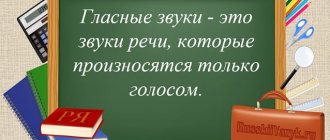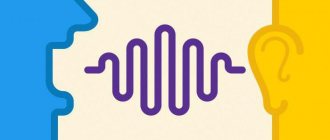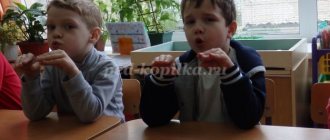A - Alyonushka’s “crying”; her mouth is open as wide as the ends of the letter A - aaa.
O - the child “has a toothache”, he “moans”: ooh; his lips are shaped like the letter O.
U - locomotive whistle; children hum with their mouths open and their lips stretched out like a tube; their attention is drawn to the shape of the letter U, which is also elongated and looks like a tube (ball).
And - two vertical sticks depict the upper and lower lips in a smile, the mouth is slightly open; children imitate the cry of a foal: eee.
E - a face with a drooping lower jaw, the tongue is even visible in the mouth - the letter E also has a wavy crossbar in the middle; E - distant echo.
Y - based on the visual image of the letter I (the mouth is open “like a finger”), invite children to open their mouths even wider so that the rounded end of the tongue is visible inside, because the letter Y, unlike I, also has a rounding at the bottom - an oval; Y - onomatopoeia for a departing plane.
Games with vowel sounds and letters (A, O, U, E, I, Y)
1. “Let’s portray and sing.”
According to the instructions of the teacher, the child, looking in the mirror, shapes his lips into vowel letters, and then sings them: A - opens his mouth wide; And - lips in a smile, mouth open to a finger, etc.
2. “What do I want to sing?”
Children guess letters using silent articulation.
3. “What needs to be done?”
To pronounce E correctly, you need to lower your lower jaw, the end of your tongue will be visible in your mouth; With Y we open our mouth wider than with I, and we smile; our tongue is also visible in our mouth.
4. “Compare and find the letter.”
The teacher says, for example: “Alyonushka is crying,” the child pronounces the sound aaa, then finds the letter A.
5. “Name and show.”
One child pronounces the vowel sound, and the other says the onomatopoeia and finds the letter. Example: O - “teeth hurt” (sings the sound and finds the letter).
6. “Name the parts of the letters.”
Which vowel letters have sticks, bars, or an oval?
7. “Guess by the description.”
Two sticks connected at the top, moved apart at the bottom, forming a hut, in the middle there was a crossbar - this is the letter A; oval, donut - O; a long inclined stick, and a short one is attached to it in front - U; semi-oval, open on the left, in the middle there is a wavy crossbar - E; two sticks and an oblique crossbar from the lower end of the first stick to the upper end of the second - And; two sticks, on the first one at the bottom right there is an oval - Y.
8. “What else?”
The small letter “a” is written differently from the big one: a stick with a rounded bottom, a rounded shape at the top left, and an oval at the bottom.
9. “Describe the letter.”
Children give descriptions of the given letters, taking them from the typesetting canvas.
10. “Compare the letters.”
An example of a comparison of the spelling of the letters O, E: O is a complete oval; E - half an oval (incomplete oval) and in the middle there is a crossbar.
The study of consonant letters begins only after children acquire the ability to accurately identify these sounds at the beginning of a word, or after mastering a complete sound analysis of words like poppy.
The assimilation of each printed letter is based on its similarity to an object whose name begins with the same sound. Children quickly remember similar objects, and only then letters.
So, looking at D, the child first pronounces house, and then adds D.
To correctly name objects with all consonant letters except I, children need no more than two or three lessons, after which they are asked to remember the object silently, and say out loud only the sound at the beginning of the word and show the corresponding letter. When naming a sound, it is recommended not to open your mouth at all in order to avoid receiving the overtone “e” - be, de, which interferes in the future with combining sounds into syllables and words when mastering reading and composing words.
How to learn consonants?
Once you have learned the basic vowels ( a , u , and , o ) you can move on to consonants. You need to start with the simplest consonants ( b , p , m , n , t , g ). And here again we remember that we teach the child sounds, not letters. We know that we need to say “ um ”, “ en ”, “ be ”, but children don’t need to know this yet. The child must learn that this is the sound “ mm ” or the sound “ nn ”. After the baby has mastered simple consonants, you can move on to studying sibilants.
Just like with vowels, knowledge needs to be consolidated. Children may confuse letters. To prevent this from happening, play association games. You can ask the children to think of what the letter looks like. Look for objects on the street that resemble this letter. For example, you walked past a horizontal bar, it is shaped like the letter “ p ”, or look at the doorway, it is also shaped like a “ p ”. Make it out of pencils, look for it in store signs.
Methods for learning the alphabet
There are several popular methods for teaching children to read and memorize the letters of the alphabet. You can use them, especially since experts worked on them. But, no matter what method you work with, it is important to remember that your classes should not resemble lessons at school.
Children at this age need to play and get the information they need through games. Therefore, after a short educational part, immediately move on to an interesting, gaming part. Creative activities are also very useful, with the help of which you not only learn letters, but also develop the child’s fine motor skills, improve his drawing and coloring skills, and strengthen the ability to use scissors.
Games and play exercises
There are a huge number of game exercises that will help you consolidate your knowledge. We will give a few as examples.
1. Find words with the right sound . You need to prepare cards that show different objects. The child must choose among them those that contain the sound being studied. First, you can simplify the task: ask him to find words starting with this letter.
2. Catch the sound . To warm up a little, mother and child walk around the room. Mom says different words. As soon as the child hears a word with the desired sound, he stops and claps his hands.
3. Come up with a word . Ask your child to come up with as many words as possible with a certain sound. You can do this in turn, for example, first the mother says the word, then the baby.
The task needs to be made more difficult, that is, the sound can be not only at the beginning of the word, ask him to come up with a word in which this sound will be at the end or in the middle. For example, you are learning the sound “a”. First, select words that begin with this letter - apricot, orange, then those that end in “a” - Moscow, jellyfish or contain the sound “a” in the middle - mosaic, eye.
4. Determine where the sound is hidden . You need to draw a simple diagram of the word: three squares connected to each other. Each square represents its own: the beginning of the word, the middle and the end. Place this word diagram in front of the child and give him the chip.
You name different words, and he should show on the diagram where the sound you are going through is located. For example, if you named the word “watermelon” (you can show a picture), the child should put the chip in the 1st cell, and if the word “fox” - then in the 3rd cell.
5. Playing with the ball . An adult throws a ball to the child and says different words. If they contain the letter being studied, he catches the ball, if not, then he does not catch it. To begin with, you can use words in which this letter is at the beginning, then complicate the task, that is, it can be in the middle or at the end.
Author's methods for learning the alphabet
There are several recognized methods of teaching reading, each of which can be devoted to a separate article.
Zaitsev cubes
The basis of Zaitsev’s method is play, that is, children simply play with cubes (there are 52 cubes of different sizes in a set) and at the same time learn to read without making any effort. These games can be started from 6-12 months, but until 2 years old they are used like regular blocks, and children after 2 years old can begin to form words.
Zaitsev's main unit is a warehouse. It can consist of a consonant and a vowel, or of one letter. The basis of this method is the warehouse principle of reading. In addition to the cubes, a large storage table is also used.
This technique has many advantages, the main one of which is that any child can be taught to read. But there are also some disadvantages, for example, over time, children will have to be retrained, because they remember that letters are indicated by one color, and the teacher introduces his own colors, for example, red is a vowel letter. In addition, the child is accustomed to the fact that words are divided into clauses, and not into syllables. And benefits are very expensive.
Doman cards
Neurosurgeon Glen Doman developed his technique for children with central nervous system disorders, but then they began to use it to teach healthy children. He recommends teaching children to read not by letters, but by words, since letters mean nothing to him, and words have real meanings.
To do this, whole words are written on cards in large font (at least 7-10 cm), for example, “mom” or “dad,” which must be quickly shown to the child, voicing each word. Using this method, you can teach even a small child to read. Training must be carried out at an early age; after 5 years, Glen Doman’s method no longer works.
Methodology of Olga Soboleva
The principle of this training is based on the “bihemispheric” work of the brain. The teacher tries to use the dominant type of memory, that is, the material is divided into 3 groups: for kinesthetic, visual and auditory learners.
Many of its techniques are also used by ordinary teachers when teaching traditional methods to make it more interesting for children to study. Good for creative children and parents, it is not recommended for families where logic and structure come first.
Polyakov's technique
Its author came up with 7 steps of learning to read, a total of 70 lessons. Each lesson is described in detail. They are conducted in a playful manner and take no more than 10 minutes. Stages 1 and 2 are the study of letters, spellings, reading by spellings.
Sergei Nikolaevich Polyakov himself, unfortunately, is no longer alive, but his work was continued by his son, as well as teachers who practice this method. If you wish, you can purchase books that describe in detail how to conduct classes, as well as video files with examples of classes.





